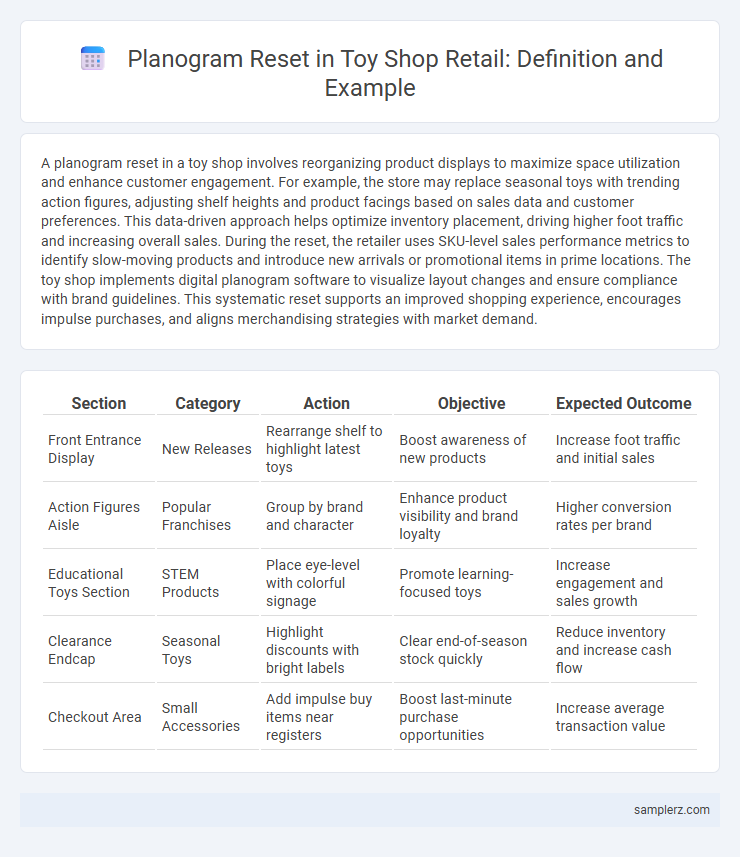A planogram reset in a toy shop involves reorganizing product displays to maximize space utilization and enhance customer engagement. For example, the store may replace seasonal toys with trending action figures, adjusting shelf heights and product facings based on sales data and customer preferences. This data-driven approach helps optimize inventory placement, driving higher foot traffic and increasing overall sales. During the reset, the retailer uses SKU-level sales performance metrics to identify slow-moving products and introduce new arrivals or promotional items in prime locations. The toy shop implements digital planogram software to visualize layout changes and ensure compliance with brand guidelines. This systematic reset supports an improved shopping experience, encourages impulse purchases, and aligns merchandising strategies with market demand.
Table of Comparison
| Section | Category | Action | Objective | Expected Outcome |
|---|---|---|---|---|
| Front Entrance Display | New Releases | Rearrange shelf to highlight latest toys | Boost awareness of new products | Increase foot traffic and initial sales |
| Action Figures Aisle | Popular Franchises | Group by brand and character | Enhance product visibility and brand loyalty | Higher conversion rates per brand |
| Educational Toys Section | STEM Products | Place eye-level with colorful signage | Promote learning-focused toys | Increase engagement and sales growth |
| Clearance Endcap | Seasonal Toys | Highlight discounts with bright labels | Clear end-of-season stock quickly | Reduce inventory and increase cash flow |
| Checkout Area | Small Accessories | Add impulse buy items near registers | Boost last-minute purchase opportunities | Increase average transaction value |
Introduction to Planogram Resets in Toy Shops
Planogram resets in toy shops involve rearranging product displays based on updated sales data and customer behavior insights to maximize shelf space and improve product visibility. Retailers analyze toy category performance, seasonal trends, and new product launches to create merchandising layouts that drive higher engagement and purchase rates. Effective planogram resets enhance shopper experience by strategically positioning popular and high-margin toys at eye level or promotional zones.
Importance of Planogram Resets for Toy Retailers
Planogram resets in toy shops optimize shelf space by aligning product placement with seasonal trends and consumer preferences, driving increased sales and customer satisfaction. Detailed analysis of sales data and demographic insights enables toy retailers to strategically arrange best-selling and promotional items for maximum visibility. Regular planogram updates reduce inventory surplus and improve stock turnover, enhancing overall store profitability and shopper experience.
Step-by-Step Guide to Toy Shop Planogram Reset
Rearranging toy shelves begins by analyzing current sales data to identify high-demand products and seasonal trends. Next, categorize toys by age group, theme, and size to enhance customer navigation and maximize shelf visibility. Finally, use planogram software to digitally map the new layout, ensuring optimal product placement while maintaining inventory balance and promotional displays.
Key Tools and Resources Needed for a Toy Shop Reset
Effective planogram resets in toy shops require detailed SKU data analysis and digital planogram software like Blue Yonder or Relex to optimize shelf layouts for product visibility and seasonal trends. Essential resources include handheld inventory scanners, adjustable shelving units, and branded point-of-sale displays to enhance merchandising impact and streamline restocking processes. Collaboration with suppliers for timely product delivery and promotional materials supports maintaining optimal stock levels and customer engagement during the reset.
Pre-Reset Inventory Assessment in Toy Stores
Pre-reset inventory assessment in toy stores involves a thorough audit of existing stock to identify slow-moving, seasonal, and high-demand products, ensuring optimal shelf space allocation. Data from sales history and current inventory levels are analyzed to forecast potential changes in consumer preferences and adjust product placements accordingly. This strategic evaluation supports an effective planogram reset by minimizing stockouts and overstock situations, enhancing customer shopping experience and maximizing sales performance.
Example Layout Changes During a Toy Shop Reset
Planogram reset in a toy shop often involves reorganizing shelves to highlight seasonal products, such as placing popular action figures at eye level and grouping educational toys by age category to enhance customer engagement. Shelf space is reallocated to introduce new product lines and improve cross-selling opportunities, like positioning board games adjacent to puzzles. Visual merchandising elements, including themed signage and interactive displays, are adjusted to create an immersive shopping experience that drives impulse purchases.
Visual Merchandising Strategies for Toy Planograms
Toy shop planogram resets optimize shelf space by grouping products by age range, theme, and brand to enhance customer navigation and increase sales. Visual merchandising strategies include using bright colors, interactive displays, and eye-level placement of trending toys to capture attention and encourage impulse buys. Incorporating seasonal themes and cross-promoting complementary products further drives engagement and improves overall store aesthetics.
Common Challenges in Toy Shop Planogram Resets
Frequent challenges in toy shop planogram resets include managing space constraints while maximizing product visibility and ensuring age-appropriate categorization to enhance customer experience. Balancing high-demand seasonal items with evergreen toys often complicates inventory placement and shelf arrangement. Inconsistent planogram execution across multiple store locations can lead to reduced brand consistency and diminished sales performance.
Measuring the Impact of a Successful Reset
Measuring the impact of a planogram reset in a toy shop involves analyzing key performance indicators such as sales lift, inventory turnover, and customer engagement metrics within the first 30 days post-reset. Tracking SKU-level sales data and comparing it to pre-reset benchmarks reveals shifts in product demand and highlights the effectiveness of new visual merchandising strategies. Utilizing heat maps and shopper path analytics further quantifies improvements in store navigation and product accessibility, ensuring the reset aligns with optimized retail performance goals.
Best Practices for Ongoing Planogram Maintenance in Toy Shops
Regularly updating planograms in toy shops ensures optimal product placement based on seasonal trends and consumer behavior data. Incorporate sales analytics and customer feedback to adjust shelf space, prioritize high-demand toys, and introduce new product lines effectively. Consistent staff training on visual merchandising standards helps maintain shelf organization and enhances the overall shopping experience.

example of planogram reset in toy shop Infographic
 samplerz.com
samplerz.com